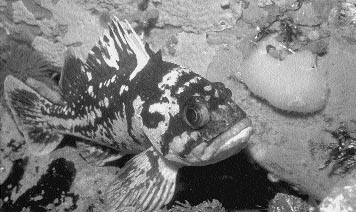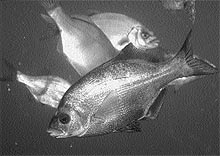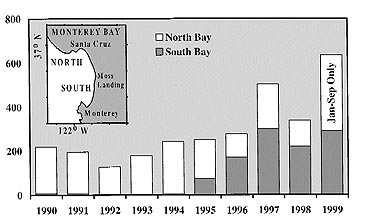|
|

|
|

|
The
Status of the Nearshore Live Fish Fishery
and the Need for Effective
Management
|

|
|

|
|
Black
and yellow rockfish (©Don
Gotshall)
|
|
Status of
Fishing
Fish populations within the Monterey
Bay National Marine Sanctuary remain
healthy. The El Niño and La
Niña phenomena of the last two
years have influenced the migration
patterns of some species of fishes, but
the stocks in general are still abundant.
An exception would be some rockfish
stocks, which are healthy but appear to be
somewhat depressed at this time.
Probably one of the most unusual
occurrences this past year was the
appearance of bluefin tuna within
Sanctuary waters; some were even caught in
Monterey Bay.
This year most of the squid in Monterey
Bay have gone into deep water and cannot
be reached by the commercial fishermen's
nets. Bluefin tuna caught in these deep
waters were found to be feeding heavily on
squid. Record numbers of squid are now
being caught south of our Sanctuary near
Point Hueneme and the Channel Islands.
Last year, because of El Niño,
salmon fishing within the Sanctuary was
disappointing. The 1999 season, however,
has proven to be a banner year.
Surprisingly, most of the salmon didn't
venture into Monterey Bay itself, but were
found in abundance between Santa Cruz and
the northern boundary of our Sanctuary.
Good fishing was also reported off the
Monterey Peninsula and Carmel Bay. Salmon
this year were of excellent quality,
averaging more than two pounds per fish
heavier than usual.
While sardines remain abundant in
Monterey Bay, their size is somewhat
smaller than usual. The larger sardines
have been found in the northern part of
our Sanctuary, off Half Moon Bay and up to
the waters off British Columbia. The
entire West Coast is witnessing the
re-emergence of this magnificent
resource.
--Dave Danbom
Fishing Industry Representative,
Monterey Bay National Marine
Sanctuary Advisory Council
|
Nearshore
fisheries have existed in California for decades,
but a recent fishery for live fishes used in local
restaurants and shipped overseas started in
southern California in the late 1980s, spread to
northern California in the early 1990s, and now has
become common in central California. These fishing
boats use hook and line, pole fishing, and traps.
Live finfish in California comprise more than 60
percent of the annual nearshore fish landings,
which have increased from approximately 20,000 to
more than a million (M) pounds and from
approximately $20,000 to $2.7 M in value in the
past eight years. Between five and fifty species,
depending upon location, season, and year, are
landed in this fishery.
Recently, the California
Department of Fish and Game (CDFG) created teams to
deal with specific fishery issues. The Nearshore
Fish Team has met several times to discuss how to
evaluate and regulate, if necessary, the live fish
fishery. In its spring 1999 meeting, the team noted
many gaps in knowledge on this fishery and its
target species, including accurate estimates of the
abundance (from both fishery-dependent and
-independent catch and effort data sources),
species composition, natural history, bycatches,
effect of changing ocean conditions, socio-economic
factors, and the ecosystem role of species subject
to fisheries. The team estimated that the costs of
doing the necessary research to fill these gaps
would be approximately $10 M just for the first
year!
Some scientists think the
live fish fishery will fail because it targets
mainly small, immature individuals of shallow,
nearshore fishes. Certainly, fisheries for juvenile
fishes, especially if they target all areas where
these juveniles live, cannot last long. Of special
concern is the fact that many of these fishes are
being harvested before they get a chance to
reproduce for the first time. Since rockfish are
typically long-lived, often take many years to
mature, and are known to have highly-variable,
successful recruitment, harvesting them before they
mature and reproduce can be disastrous for their
populations.
In addition, the live fish
fishery targets sizes and species of fishes not
taken by many fishermen prior to now. Many of these
nearshore fishes are very site-intensive. Thus, any
heavy fishing on their populations—most of which
have established home sites and will not move much
after settling, except to forage and perhaps
reproduce—could be very deleterious to the local
population densities.
In June 1999 the U.C. Sea
Grant Marine Advisory Program and CDFG sponsored a
Workshop on Assessing and Managing Nearshore
Fisheries. Recommendations from fishery biologists
who attended include the need to obtain the best
possible data on catch, effort, species and size
composition, reproduction, maturity, location, site
specificity, larval dispersal and recruitment, and
socio-economic variables to enable CDFG to evaluate
the trends in this increasing fishery and manage it
appropriately.
Two pieces of California
legislation, enacted in 1998, require Fishery
Management Plans (FMPs), shift the nearshore
fishery regulatory authority from the California
Legislature to the Fish and Game Commission, and
establish size limits for selected species. Size
limits between 10-12" were established for six
species of rockfish, including the black and
yellow, gopher, kelp, China, grass, and brown
rockfishes, and limits of 10" for scorpionfish, 12"
for sheephead, and 14" for cabezon. Other species
taken in this fishery include greenlings,
surfperches, deep-water thornyhead fishes, and
crustaceans such as the spot prawn. However, for
most of these species, there have not been
validated age determination or estimates of
age/size at maturity studies. Also, size limits may
not be very effective because many of the
undersized fishes with swim bladders will suffer
barotrauma (disorientation and possible death
caused by pressure change) and not survive well
when returned to the sea.
|

|
|
Pile
surfperch (©Don
Gotshall)
|
Without better information on the life histories
of these species and on the status of their
populations, adequate FMPs will be difficult to
produce. In addition, regulations will continue to
be difficult to enforce due to the transient nature
of the nearshore fish fishery and delivery systems
and the limited enforcement available. More
accurate information on the fishery, habitat
requirements, and life histories of these fishes is
needed to ensure that sufficient management
policies are enacted to guarantee the continued
health of these nearshore fish
assemblages.
--Gregor M.
Cailliet
Moss Landing Marine Laboratories
|

|
Monitoring
Marine Mammal and Seabird Bycatch in the
Monterey Area Set Gillnet
Fishery
|

|
During
the 1980s extensive bycatch of seabirds and marine
mammals in central California's set gillnet
fisheries prompted a series of regulations, which
ultimately appear-ed successful at reducing
mortality of the three species of primary concern:
Common Murre, sea otter (Enhydra lutris) and harbor
porpoise (Phocoena phocoena). A National Marine
Fisheries Service (NMFS) observer program provided
bycatch data from 1990 to 1994, and was
discontinued after 1994 because bycatch of harbor
porpoise was low and no sea otters were observed
entangled after 1990.
In August 1997, however,
an unusual seabird stranding event was detected by
the Monterey Bay National Marine Sanctuary's Beach
COMBERS program (see Bird
Section for program
details). Several hundred dead Common Murres were
found on a 14-km section of beach in southern
Monterey Bay. Because of the localized nature of
the strandings, and because Common Murres had a
history of significant mortality in gillnets,
fishery entanglement was considered a possible
cause of death for these birds.
Halibut set gillnet
fishery records revealed that effort had increased
substantially between 1994 and 1998 and had also
shifted to the southern areas of Monterey Bay
(Figure 1). Increasing effort was taking place just
offshore of the beaches exhibiting high seabird
deposition rates. This area historically had high
bycatch rates of harbor porpoise, southern sea
otter, and Common Murres. There was, therefore,
concern over potential increased fishery mortality
for all three species, particularly given an
increase in harbor porpoise stranding rates and an
apparent decline in the sea otter population after
1995 (see article in Endangered
Species section). Without
observer data for 1995-98, however, it was not
possible to estimate accurately the level of
mortality during those years.

|
|
Figure
1: Halibut set gillnet fishery effort for
Monterey Bay in the 1990s.
|
In April 1999 NMFS reinstated an observer program
for the Monterey Bay area set gillnet fishery.
Approximately 25 percent of fishing effort was
observed between April and September, providing
much-needed data on marine mammal and seabird
entanglements. Observed mortalities for this
six-month period included 26 harbor porpoises, 1
unidentified cetacean (almost certainly a harbor
porpoise), 47 harbor seals, 4 elephant seals, 5
California sea lions, 1 southern sea otter, and 286
Common Murres. Although overall mortality estimates
are not yet available, simple extrapolation
indicates that about 100 harbor porpoises, 1,000
Common Murres, and up to 4 sea otters may have died
in Monterey Bay area gillnets during this
period.
Multi-agency efforts are
presently underway to evaluate and address this
mortality. The central California harbor porpoise
population is estimated to be about 5,700 animals,
and under the Marine Mammal Protection Act, the
maximum allowable incidental mortality of this
species is forty-two animals per year. NMFS is
therefore currently working with fishermen to
implement voluntary measures to reduce the
mortality of harbor porpoise, including the use of
acoustical devices ('pingers'), which have been
extremely effective at reducing marine mammal
entanglements in other gillnet fisheries. Studies
are also underway to identify the potential impacts
of the present gillnet mortality on southern sea
otters and Common Murres.
--Karin A. Forney
Southwest Fisheries Science Center
|

